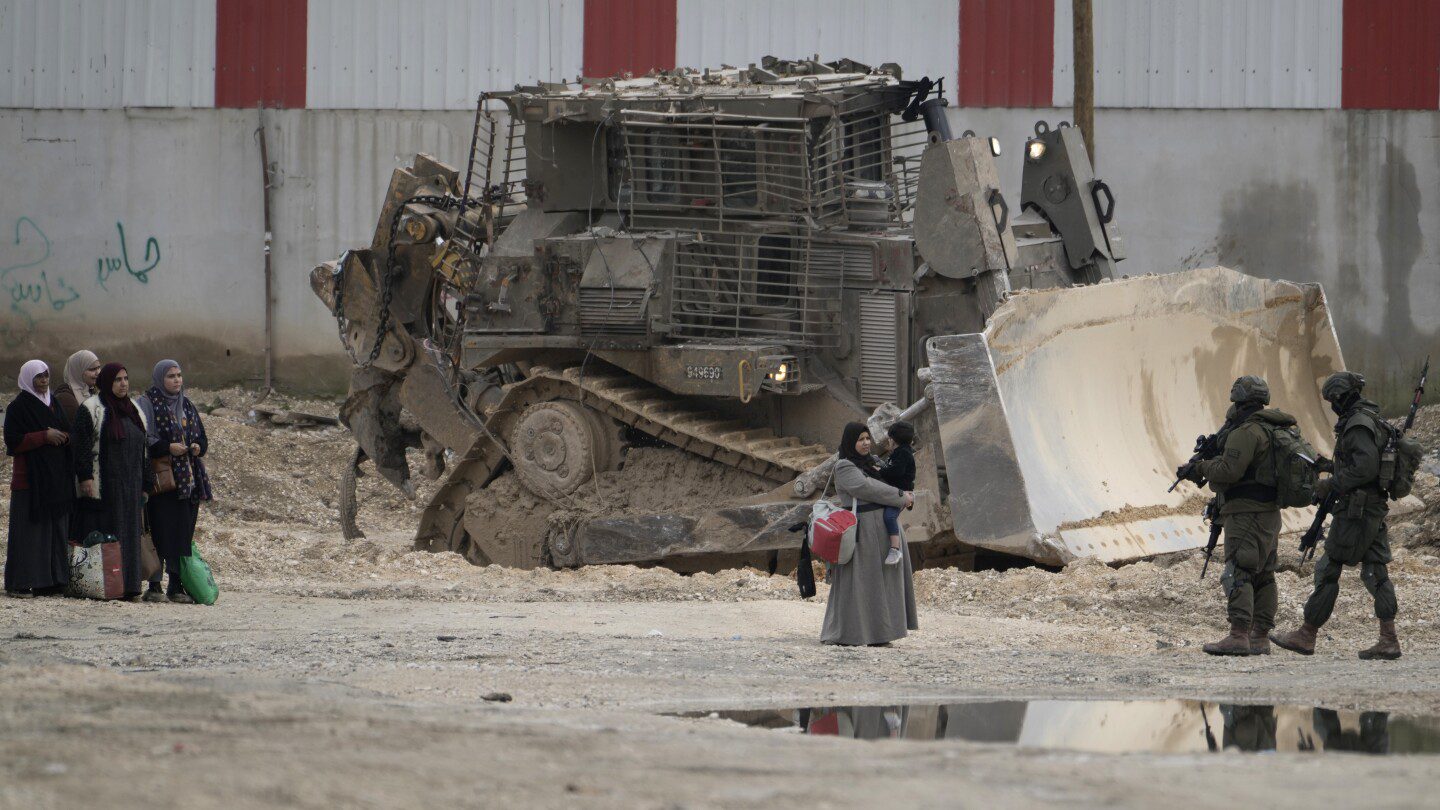
FAR’A REFUGEE CAMP, West Bank (AP) — In recent weeks, tens of thousands of Palestinians have been forced to flee Israeli military operations throughout the northern West Bank, marking the largest displacement in the occupied territory since the 1967 Middle East conflict. Families have navigated muddy olive groves and dangerous sniper zones, both by car and on foot, in a desperate attempt to escape the escalating violence.
Following a broad announcement on January 21 regarding a crackdown on militants in the West Bank—just two days after reaching a ceasefire agreement with Hamas in Gaza—Israeli forces intensified operations in the turbulent city of Jenin. This was part of a broader strategy employed multiple times since the October 7, 2023, attack on Israel by Hamas.
However, this time, the Israeli military operation extended more aggressively into adjacent towns like Tulkarem, Far’a, and Nur Shams, leading to family separations and evoking painful memories of the 1948 war associated with Israel’s establishment. During that conflict, approximately 700,000 Palestinians were displaced, a tragedy referred to as “Nakba,” meaning catastrophe—an event that still resonates in the crowded towns, now known as refugee camps.
“This feels like our nakba,” expressed Abed Sabagh, a 53-year-old father, as he hurriedly packed his seven children into the car on February 9 amidst the chaos of sound bombs echoing in Nur Shams camp, where he was born to parents who had previously escaped the 1948 conflict.
Similar Tactics as Gaza
According to humanitarian officials, the scale of displacement in the West Bank has not been seen since the 1967 Middle East War, which resulted in Israel seizing territories such as eastern Jerusalem and the Gaza Strip, further displacing an additional 300,000 Palestinians. “This situation is unprecedented. As infrastructure gets destroyed, we are approaching conditions where the camps may soon become uninhabitable,” warned Roland Friedrich, head of West Bank operations for the U.N. Palestinian refugee agency. Over 40,100 Palestinians have reportedly vacated their homes amid the current military actions, as per agency reports.
Experts observe that the operational tactics employed by Israel in the West Bank are increasingly resembling those used in Gaza. Following the former President Donald Trump’s controversial plan for the large-scale relocation of Palestinians from Gaza, far-right factions in Israel have intensified their calls for the annexation of the West Bank. “The notion of ‘cleansing’ the land of Palestinians is gaining traction like never before,” stated Yagil Levy, director of the Institute for the Study of Civil-Military Relations at Britain’s Open University.
The Israeli army, however, denies claims of issuing evacuation orders in the West Bank, suggesting that they are simply securing passages for those who wish to leave voluntarily.
Evacuated Under Duress
Numerous displaced Palestinians interviewed recently shared that they fled not solely out of fear but due to direct orders from Israeli security personnel. Journalists from the Associated Press heard Israeli soldiers using mosque loudspeakers to instruct locals to evacuate.
While some families recounted being treated politely, with soldiers knocking on doors and assuring them they could return, others detailed experiences of aggression, with troops ransacking their homes and hastily forcing residents out, despite desperate pleas for additional time.
“I was crying, pleading with them, ‘Why must I leave my home? My baby is upstairs, just allow me to get my child, please!’” recalled Ayat Abdullah, 30, from a shelter in the village of Kafr al-Labd. “They gave us just seven minutes. Thankfully, I managed to take my children but nothing else.”
After being told to find their own way, Abdullah trudged approximately 10 kilometers (around six miles) along a path illuminated only by her phone’s light, as rain transformed the ground into mud. She held her children tightly, aware of the dangers posed by snipers, who had recently taken the life of a pregnant woman just hours prior on February 9.
“Yes, my love,” she agreed with her 5-year-old son Nidal, who interrupted her tale with a buzzing sound. “That’s exactly the noise the drones made as we left our home.”
Welcoming Assistance, for Now
In the town of Anabta, volunteers are tirelessly assisting in mosques and government buildings turned makeshift shelters, delivering essential supplies like blankets, serving coffee, and preparing meals. Community members are opening their doors to families fleeing from Nur Shams and Tulkarem.
“It’s our duty given the current situation,” remarked Thabet A’mar, the mayor of Anabta, although he stressed that this show of hospitality is intended as temporary.
Refusing to Leave
As the invasion unfolded beginning February 2, Israeli bulldozers caused significant damage, rupturing underground pipes, cutting off water supply, and creating chaos with sewage overflow. Schools closed, food became scarce, and sounds of explosions filled the air.
Ahmad Sobuh comprehended why some of his neighbors chose to leave the Far’a refugee camp during the Israeli military’s extensive operations. However, he opted to remain, collecting rainwater for drinking and vowing to himself, his family, and the soldiers banging on his door that he would not abandon his home.
On February 11, soldiers warned Sobuh’s family that they were planning to demolish the second floor of their house because it allegedly raised suspicions of housing security cameras and a suspicious object. After searching, he discovered a water pipe belonging to his nephew, which soldiers had mistaken for a weapon.
The subsequent explosion left the second floor of the family’s home exposed to the elements, completely destroyed most other rooms, and made remaining there untenable. “They are doing everything possible to push us out,” Sobuh lamented, noting that the UN agency for refugees reported that hundreds of homes in four camps had been demolished this year.
The Israeli military maintains that its operations are critical counterterrorism actions aimed at preventing incidents similar to the attacks of October 7, highlighting that they have made efforts to minimize civilian impact.
A Haunting Return
Upon returning ten days later to her family’s five-story residence, Doha Abu Dgheish was immediately struck by a foul odor. As she entered following the withdrawal of Israeli forces from Far’a camp, she noticed remnants of spoiled food and unsanitary conditions. Their pet parakeets were gone, and pages of the Quran had been desecrated with disturbing images. Every door in the house had been forcibly blown off its hinges, despite not being locked.
As her 11-year-old daughter, who has Down syndrome, found her damaged doll, screams erupted from the child. Reporting on this situation, AP journalists were present shortly after the family returned on February 12.
Nearly two dozen Palestinians from various refugee camps shared with reporters instances of military units commandeering civilian residences to use as makeshift dormitories or observation posts. The Abu Dgheish family accused Israeli soldiers of vandalizing their property, a sentiment echoed by numerous families within Far’a.
The Israeli army claims that militants have embedded themselves within civilian infrastructure. It noted that soldiers might be required to operate from homes for certain periods, stating that any significant incidents requiring further investigation would be addressed, though specifics were not provided.
For Abu Dgheish, the overwhelming mess represented the emotional upheaval that comes with returning home, leaving them uncertain when they may be forced to evacuate again. “It’s as if they want us to feel perpetually unsafe,” she lamented. “That we lack any control.”









